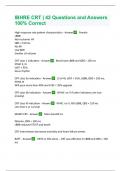Crt class 1 indication - Study guides, Class notes & Summaries
Looking for the best study guides, study notes and summaries about Crt class 1 indication? On this page you'll find 61 study documents about Crt class 1 indication.
All 61 results
Sort by
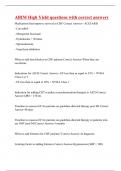
-
ABIM High Yield questions with correct answers
- Exam (elaborations) • 53 pages • 2023
- Available in package deal
-
- $14.99
- + learn more
Medications that improve survival in CHF Correct Answer-- ACEI/ARB - Carvedilol - Metoprolol Succinate - Hydralazine + Nitrates - Spironolactone - Neprilysin inhibitors When to add beta blocker in CHF patients Correct Answer-When they are euvolemic Indications for AICD Correct Answer-- EF less than or equal to 35% + NYHA Class 2 or 3 - EF less than or equal to 30% + NYHA Class 1 Indication for adding CRT (cardiac resynchronization therapy) to AICD Correct Answer-QRS > 150 m...
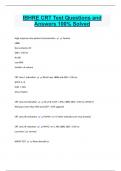
-
IBHRE CRT Test Questions and Answers 100% Solved
- Exam (elaborations) • 7 pages • 2024
- Available in package deal
-
- $9.99
- + learn more
IBHRE CRT Test Questions and Answers 100% Solved High response rate patient characteristics Female LBBB Non-ischemic HF QRS > 150 ms No MI Low BMI Smaller LA volume CRT class 1 indication Must have LBBB and QRS > 150 ms NYHC II, III LVEF < 35% Sinus rhythm CRT class IIa indication (3 of 4): LVEF < 35%, LBBB, QRS > 150 ms, NYHA III Will pace more than 40% and LVEF < 35% upgrade CRT class IIb indication NYHA I or II if other indicators are true (mostly) CRT class...
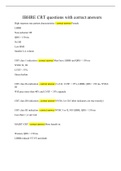
-
IBHRE CRT questions with correct answers
- Exam (elaborations) • 6 pages • 2023
- Available in package deal
-
- $7.99
- + learn more
High response rate patient characteristics - correct answer Female LBBB Non-ischemic HF QRS > 150 ms No MI Low BMI Smaller LA volume CRT class 1 indication - correct answer Must have LBBB and QRS > 150 ms NYHC II, III LVEF < 35% Sinus rhythm CRT class IIa indication - correct answer (3 of 4): LVEF < 35%, LBBB, QRS > 150 ms, NYHA III Will pace more than 40% and LVEF < 35% upgrade CRT class IIb indication - correct answer NYHA I or II if other indicators are tr...
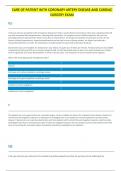
-
CARE OF PATIENT WITH CORONARY ARTERY DISEASE AND CARDIAC SURGERY EXAM
- Exam (elaborations) • 95 pages • 2024
-
- $19.49
- + learn more
CARE OF PATIENT WITH CORONARY ARTERY DISEASE AND CARDIAC SURGERY EXAMCARE OF PATIENT WITH CORONARY ARTERY DISEASE AND CARDIAC SURGERY EXAM Q1. A 55-year-old man presented to the emergency department with a 4-week history of exertional chest pain, radiating to the left arm and associated with breathlessness, sweating and clamminess. His symptoms were initially infrequent, but over the preceding week he reported them almost every day on mild exertion. He denied any episodes of chest pain a...
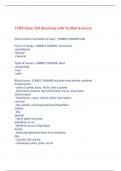
-
TCRN Exam 320 Questions with Verified Answers,100% CORRECT
- Exam (elaborations) • 57 pages • 2024
-
Available in package deal
-
- $12.99
- + learn more
TCRN Exam 320 Questions with Verified Answers Most common mechanism of injury - CORRECT ANSWER Falls Forms of energy - CORRECT ANSWER -mechanical -gravitational -thermal -chemical Types of trauma - CORRECT ANSWER -blunt -penetrating -burn -other Blunt trauma - CORRECT ANSWER accounts most injuries sustained frontal impact -aortic & cardiac injury, rib fxs, liver & spleen -dash board posterior hip fx/dislocation, femur, knee injury lateral impact -head/facial, c spine,...
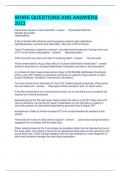
-
IBHRE QUESTIONS AND ANSWERS 2023
- Exam (elaborations) • 15 pages • 2023
-
Available in package deal
-
- $22.49
- + learn more
IBHRE QUESTIONS AND ANSWERS 2023 Name three causes of atrial standstill Myocardial Infarction Digitalis glycosides Hyperkalemia A 59 yo female with ischemic cardiomyopathy presents with palpitations, lightheadedness, insomnia and feels jittery. She has a CRT-D device. Takes Furosemide, potassium, lisinopril, carvedilol and amiodarone. Seeing short runs of VT on her device interrogation. Hyperthyroidism What would be your best next step for ordering tests? Thyroid panel ...
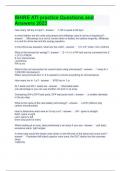
-
IBHRE ATI practice Questions and Answers 2023
- Exam (elaborations) • 10 pages • 2023
-
Available in package deal
-
- $22.99
- + learn more
IBHRE ATI practice Questions and Answers 2023 How many HZ are in bpm? 1 HZ is equal to 60 bpm In what relation are the units microamps and milliamps used in terms of equations? Microamps is a unit of current drain of battery for battery longevity. Milliamps is a unit for ohms law and the energy equation. In the Ohms law equation, what are the units? V=I x R: Volts= mA x kOhms What is the formula for energy? E = V x I x PW and can be converted into E = (V^2 x PW)/R. E i...
IBHRE CRT | 42 Questions and Answers 100% Correct
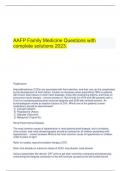
-
AAFP Family Medicine Questions with complete solutions 2023.
- Exam (elaborations) • 147 pages • 2023
-
- $11.39
- + learn more
AAFP Family Medicine Questions with complete solutions 2023. Pioglitzaone thiazolidinediones (TZDs) are associated with fluid retention, and their use can be complicated by the development of heart failure. Caution is necessary when prescribing TZDs in patients with known heart failure or other heart diseases, those with preexisting edema, and those on concurrent insulin therapy - correct answers.A 70yo M with h/o HTN and DM presents with a 2-mo h/o increasing paroxys...
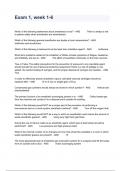
-
Anesthesia-Chapter Review Questions Part 1
- Exam (elaborations) • 13 pages • 2024
-
- $8.39
- + learn more
Anesthesia-Chapter Review Questions Part 1 1. A drug-induced state of calm in which the patient is reluctant to move and is aware of but unconcerned about its surroundings. a. Sedation b. Hypnosis c. Narcosis d. Tranquilization - ANS d. Tranquilization 2. The term regional anesthesia refers to: a. Loss of sensation in a limited area of the body produced by administration of a local anesthetic or other agent in proximity to sensory nerves b. Loss of sensation in a small are...

Study stress? For sellers on Stuvia, these are actually golden times. KA-CHING! Earn from your study resources too and start uploading now. Discover all about earning on Stuvia



